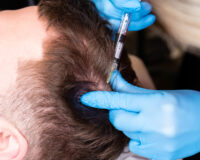If you’ve recently had botox or are thinking of starting your botox journey, you might be wondering how often it will need to be topped up.
In short, how often you should top up botox depends on a whole range of factors, such as the severity of your wrinkles, your age, the treatment area and your metabolism. That said, the average time frame for Botox efficacy is around 4 months, and after that time period, it’s likely that you’ll start to see your original facial lines begin to re-form. For this reason, many people like to top up botox every 3-4 months.
Factors That Influence the Frequency of Botox Injections
While the general rule of thumb is that botox should be topped up every 3-4 months, there are a number of factors that can influence how often you should get the top up.
Factors influencing the frequency of botox injections include:
- Age
- Treatment area
- Personal response to botox
- Dosage and quality of injector
- Health and lifestyle factors
1. Age
Age is a big contributor when it comes to how often you should get a botox top up. Factors like skin hydration, elasticity, and overall skin health can impact how long Botox lasts. For this reason, younger people with more resilience and elasticity in their skin are likely to need less frequent top-ups.
Additionally, older people often have deeper wrinkles and more significant volume loss, which will require more frequent botox treatments to achieve the desired ‘wrinkle-free’ results. As younger people in their 20’s/30’s will have milder wrinkles, they won’t need as many treatments to maintain a youthful look.

Botox also tends to last longer in younger individuals due to their more robust skin support structures, resulting in less frequent treatments.
That said, if you’re in your twenties and using botox as a preventative measure, you might want to top up your botox treatment every 3 months to ensure maximum results.
2. Treatment Area
Another factor that can influence how often you need a botox top up is the treatment area. For example, areas with more daily movement, like the crow’s feet (around the eyes) or forehead expression lines might require more frequent treatments, compared to other areas that aren’t used as much, such as the neck or jawline.
The strength and activity of your facial muscles also contributes to the frequency of botox injections. Stronger muscles may cause the effects of Botox to wear off faster because the strength of the muscles directly influences how the body processes and metabolises botox, resulting in more frequent treatments needed.
This brings us nicely onto our third point…
3. Personal Response to Botox
Each person’s metabolism and muscle strength vary, so the rate at which Botox wears off can differ from person to person. Some people have naturally stronger facial muscles, leading to faster Botox breakdown and a shorter duration of effect. Others, however, have a slower metabolism and weaker facial muscle strength, meaning that they’ll see longer effects of botox.
 The history of your previous botox treatments, including how well you responded and how long the effects lasted, will also influence the frequency of future treatments.
The history of your previous botox treatments, including how well you responded and how long the effects lasted, will also influence the frequency of future treatments. With regular botox injection treatments, muscles basically learn to remain relaxed. Over time, this can lead to a decrease in muscle activity even when the effects of Botox wear off. Muscle memory may therefore result in longer-lasting effects and potentially extend the time between Botox treatments.
4. Dosage and Quality of Injector
The dosage of Botox administered and the technique used by the healthcare professional can significantly influence how long the effects last. For example, a high initial dose will likely result in tougher, longer-lasting results, meaning patients will have a longer interval between top ups.

The quality of the injector is equally important when it comes to the frequency top ups, as a fully qualified, well-trained practitioner understands facial anatomy and correct injection techniques, allowing for correct dosing and placement of the botox, leading to better and longer-lasting results.
While botox is completely safe when carried out correctly, it does come with its own risks. This is why selecting a reliable, trained and fully qualified aesthetic practitioner is crucial to ensure you’re in safe hands.
5. Health & Lifestyle Factors
Finally, general health and lifestyle factors can have a real influence on how long the effects of botox lasts. This includes things like smoking, skin health, exercise, diet and even stress levels! Let’s look at these in a little more detail:
- Smoking – While smoking won’t immediately reverse the benefits of botox, studies show it will have an adverse effect over time. Smoking also accelerates the ageing process, contributing to the formation of wrinkles.
- Skin health – Well looked after skin, such as keeping it hydrated and well-moisturised, tends to respond much better to botox injections, and in some cases extends the duration of its effects.
- Exercise – Regular exercise improves blood circulation, which can help to maintain healthy skin and muscle tone.
- Stress levels – High stress levels can lead to increased muscle tension and facial expressions, that could contribute to the development of frown lines and general facial wrinkles.
Tips for Making Botox Last Longer
Although there’s no magic formula for making your botox last longer, there are certainly a number of things you can do to help.
- Pack on the moisturiser – The effects of botox will last much longer if you take care of your skin by moisturising in both the morning and at night. Moisturising will help the treated areas remain plump and wrinkle-free.
- Avoid strenuous exercise for the first 12 hours – This is because strenuous exercise can actually cause the botox to spread to other parts of your face, therefore reducing the benefits of your aesthetic treatment.
- Avoid sunlight for the first 2 days – UV light exposure causes inflammation at the cellular level, not only causing damage to your skin but also results in dilated blood vessels, which can shorten the lifespan of your botox treatment. To maintain your results for longer, use a high-quality, broad-spectrum SPF 30+ sunscreen on your face.
- Avoid alcohol, caffeine and blood-thinning medications 48 hours before your appointment – Alcohol and caffeine can act as blood thinners, meaning they hinder the normal clotting process and could increase bleeding and bruising. Discover more ways you can prepare for your botox appointment here.

For more tips on how to look after yourself following a botox treatment, check out our blog on ‘tips for botox aftercare’ here.
If you’re interested in our botulinum toxin training courses, or any of our other aesthetics training courses, be sure to get in touch with a member of our team today. Discover how to become a botox injector in the UK here.
You Can Clinic is one of the UK’s leading providers of aesthetic training courses and pharmaceutical supplies. Over 1000 individuals have progressed through our affordable programmes, which provide comprehensive coverage of all relevant aesthetic procedures. Available from beginner to advanced courses.
Are you interested in training in the aesthetics industry? Check out our articles on Botulinum Toxin, Weight Management, and Dermaplaning Training Courses today!
Written by Kate, for You Can Clinic.



